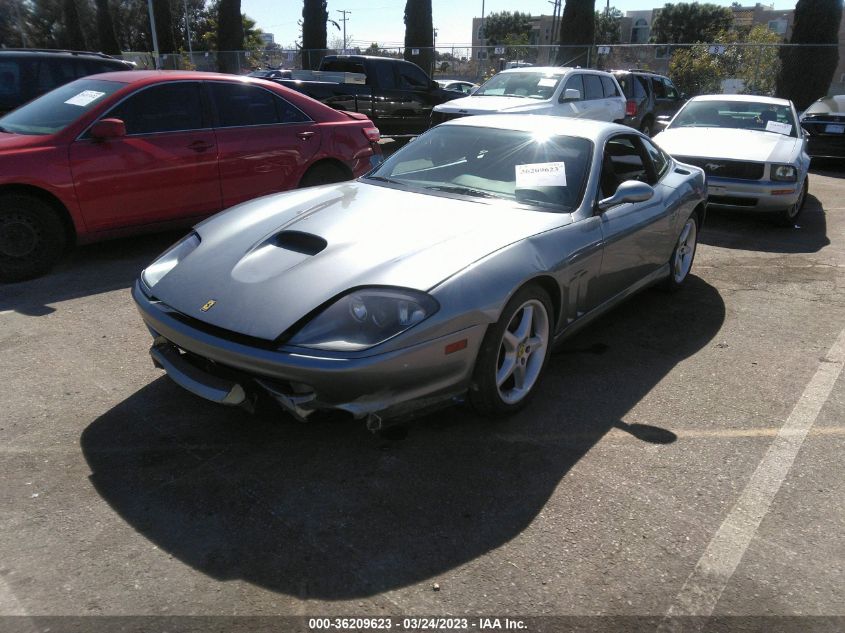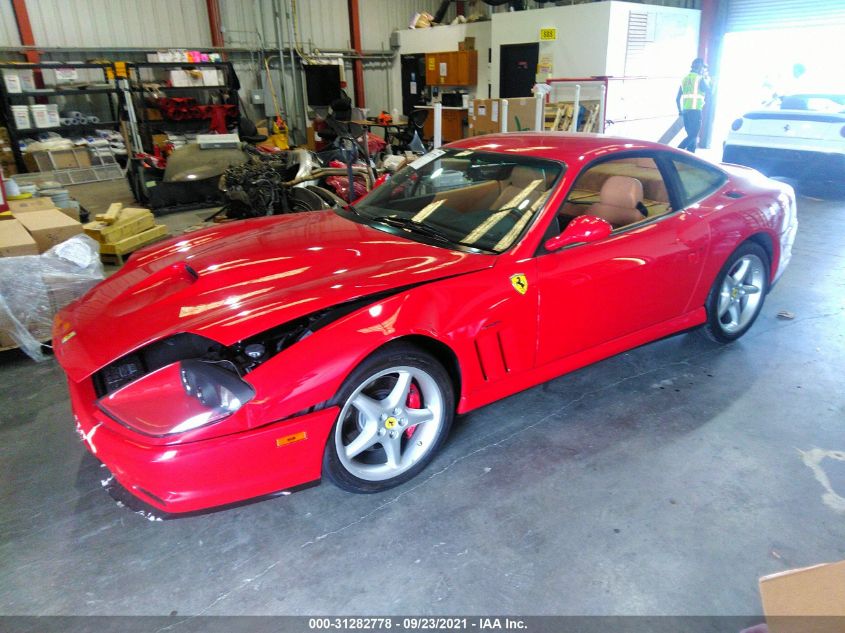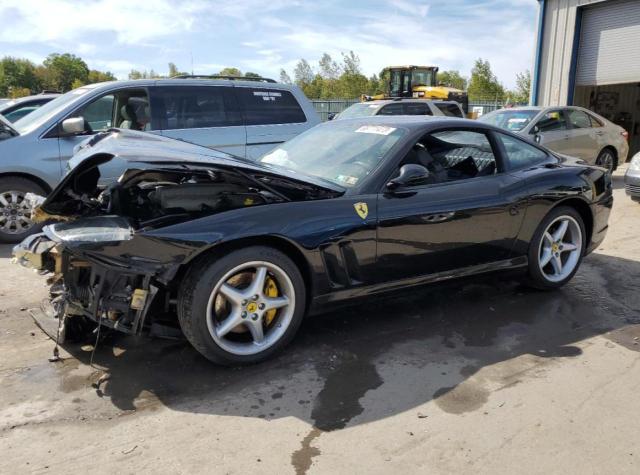2000 FERRARI 550 MARANELLO | ZFFZS49A3Y0119582
Lot details
- Sale Date2023-08-30
- Lot Number37153650
- LocationNorth Hollywood (CA)
- Odometer0 miles (0 km)
- Primary DamageENGINE DAMAGE
- SellerState Farm Group Insurance
Vehicle specifications
1
~$250,000
Engine: 5.5L naturally aspirated V12
Torque: 568 Nm
0–100 km/h: ~4.4 s
The Ferrari 550 Barchetta (2000–2002) represents the most evocative expression of front-engine V12 performance in the analog era. Powered by a naturally aspirated 5.5L V12 producing 485 hp, paired with a six-speed gated manual transmission, it delivered a raw, immersive driving experience with no electronic filters.
The Barchetta featured the same transaxle layout as the coupe, ensuring near-perfect 50:50 weight distribution. It accelerated from 0–100 km/h in 4.4 seconds, reaching a top speed near 300 km/h – figures that placed it firmly among the elite GTs of its time. Unlike its coupe sibling, the Barchetta was roofless by design, heightening the sensory thrill of the V12 soundtrack at full throttle.
Styling by Pininfarina introduced subtle updates: a shortened windshield, speed humps behind the seats, and unique alloy wheels – all contributing to a distinctive, motorsport-derived character. Despite its grand touring layout, the Barchetta’s stiff chassis, sharp steering, and balance made it a serious performer on winding roads or open highways.
The Ferrari 550 Barchetta was not just a collectible – it was a celebration of Ferrari’s V12 front-engine legacy, built at the twilight of pre-electronic performance. It earns its place in the performance registry as one of the last truly analog GTs to pair speed, beauty, and mechanical purity without compromise.
Final Bid Ferrari 550 (2000)
$31,025
$31,025
$31,025
Body Styles
Coupe (550 Maranello) – a two-door grand tourer coupe with a front-mounted V12 and a long, elegant profile. Designed by Pininfarina and built as a spiritual successor to the 365 GTB/4 Daytona, the 550 marked Ferrari’s return to front-engine V12 berlinettas after 23 years. The car featured a clamshell hood, circular taillights, pop-up headlights, and a wide, muscular stance. It delivered performance, refinement, and everyday usability in a single, cohesive package.
Convertible (550 Barchetta Pininfarina) – a limited-production open-top variant introduced in 2000 to celebrate Pininfarina’s 70th anniversary, limited to 448 units. The Barchetta featured a chopped windshield, no conventional roof (only a rudimentary canvas emergency cover), and a lower, more aggressive stance. It maintained full mechanical performance of the coupe and became an instant collectible.
Model Name Meaning (Manufacturer)
“550” refers to the engine displacement (5.5 liters), and “Maranello” pays tribute to Ferrari’s hometown and factory headquarters. The name reflects the car’s position as a classic front-V12 GT intended to embody the soul of Ferrari’s earlier touring icons. “Barchetta” means little boat in Italian – a historic term used for roofless racing Ferraris since the 1940s – while “Pininfarina” honors the legendary design house that styled it.
Model Name Meaning (Languages)
“550” and “Maranello” are globally understandable, with the numeric designation appealing to enthusiasts and the town name evoking Ferrari heritage. “Barchetta” added emotional and collector cachet, especially in Europe and the U.S., where it recalled Ferrari’s earliest open-top racers. Paired with “Pininfarina,” the name underscored craftsmanship and coachbuilt rarity.
Body & Interior Colors and Rims
The 550 was offered in a wide range of understated and iconic Ferrari finishes. Most common were Rosso Corsa, Grigio Titanio, Blu Tour de France, Argento Nürburgring, and Nero Daytona. Rarer hues like Giallo Modena, Verde Zeltweg, Grigio Ingrid, and Blu Pozzi added GT elegance. The Barchetta was often ordered in Rosso Corsa or Giallo Fly with black roll hoops and bespoke interior combinations.
Inside, the 550 featured classic Ferrari materials: leather in Cuoio, Nero, Sabbia, or Bordeaux, a gated shifter with polished steel, and analog instrumentation with timeless design. The cabin was both luxurious and driver-focused, with full electric seats, leather-trimmed dash and console, and aluminum pedal sets. The Barchetta added carbon racing seats, body-colored accents, and optional Barchetta-branded badging on the dash and seats.
Wheels were 18-inch five-spoke alloys in silver or optional anthracite. The Barchetta received unique modular split-rim wheels and center caps with Pininfarina insignia. Braking was handled by Brembo discs, with optional colored calipers (red, yellow, silver). Tailor Made clients commissioned custom upholstery, painted intake manifolds, or suede interior panels via Ferrari’s exclusive personalization program.
Top Expensive Options
- Daytona-Style Leather Seats with Perforation: ~$4,500
- Scuderia Shields on Fenders: ~$1,200
- Modular Split-Rim Wheels (Barchetta): ~$5,000
- Colored Calipers (Red, Yellow, Aluminum): ~$1,000
- Carbon Fiber Interior Trim Inserts (Barchetta only): ~$3,800
- Barchetta Plaques with Serial Number: included (limited-run only)
- Leather Rear Shelf & Custom Luggage Strap Kit: ~$2,200
- Special Paint (Historical or Metallic-to-Sample): ~$7,500
- Custom Embroidery or Contrast Stitching: ~$1,500
- Ferrari Factory Fitted Becker Navigation (Late cars): ~$2,000
vs Competitors
The Ferrari 550 Maranello marked a pivotal return for Ferrari: a front-engined, rear-wheel-drive V12 grand tourer, the first of its kind since the legendary 365 GTB/4 “Daytona.” Launched in 1996, the 550 competed directly with some of the most respected high-performance GTs of its era — including the Aston Martin DB7 Vantage, Porsche 911 Turbo (996), BMW Z8, Dodge Viper GTS, and to a degree, even the Chevrolet Corvette C5 Z06 and Mercedes-Benz SL600.
Against the Aston Martin DB7 Vantage, the Ferrari was significantly more focused and dynamically superior. While the Aston brought elegance, comfort, and a muscular V12 of its own, the 550’s 5.5-liter naturally aspirated V12, 6-speed gated manual, and advanced suspension delivered a more engaging, track-ready experience, especially at high speeds. The Ferrari also offered a more balanced chassis, better steering response, and true supercar credibility, while the Aston leaned more toward refined touring.
When compared to the Porsche 911 Turbo (996), which arrived in 2000 with all-wheel drive and twin-turbo flat-six power, the 550 offered a different kind of performance: rear-wheel-drive purity and linear, high-revving V12 power. The 911 Turbo was quicker off the line and more agile in tight corners, but the Ferrari delivered a more emotional, classically analog GT experience, with better long-distance comfort and a soundtrack that the Porsche couldn’t match.
In the case of the BMW Z8, both cars featured front-mounted V8/V12 engines and manual transmissions, wrapped in retro-inspired bodies. The Z8 had stunning looks and exclusivity, but was less composed at high speeds and lacked the Ferrari’s chassis sophistication. The 550 was also faster, more precise, and better suited to spirited driving — though the Z8 still held strong appeal for collectors due to its rarity and design.
The Dodge Viper GTS, especially in its later Phase II form, was arguably the 550’s rawest competitor. It had similar power but delivered it with far less finesse — brutal, torque-heavy, and unapologetically American. Where the Viper was loud and visceral, the 550 was smooth and grand in every sense, designed to cross continents at high speed with grace and composure.
Compared to the Mercedes-Benz SL600 of the same era, the 550 was far more performance-oriented. The SL offered luxury, straight-line power, and comfort, but lacked the Ferrari’s mechanical purity and driving connection. The Maranello’s manual transmission, rear-mounted transaxle, and near-50/50 weight distribution made it a true driver’s car, while the Mercedes catered more to cruising.
Fun Fact
The 550 was the first front-engine Ferrari with a V12 and a 6-speed manual transmission since the Daytona, reintroducing the layout that had made Ferrari icons like the 250 GT and 365 GTB/4 legendary. It was also the first Ferrari GT to be regularly used as a daily driver by owners, including Formula 1 champions and celebrities. The Barchetta Pininfarina, with its limited production and roofless purity, is now one of the most valuable and collectible V12 Ferraris of the modern era.




